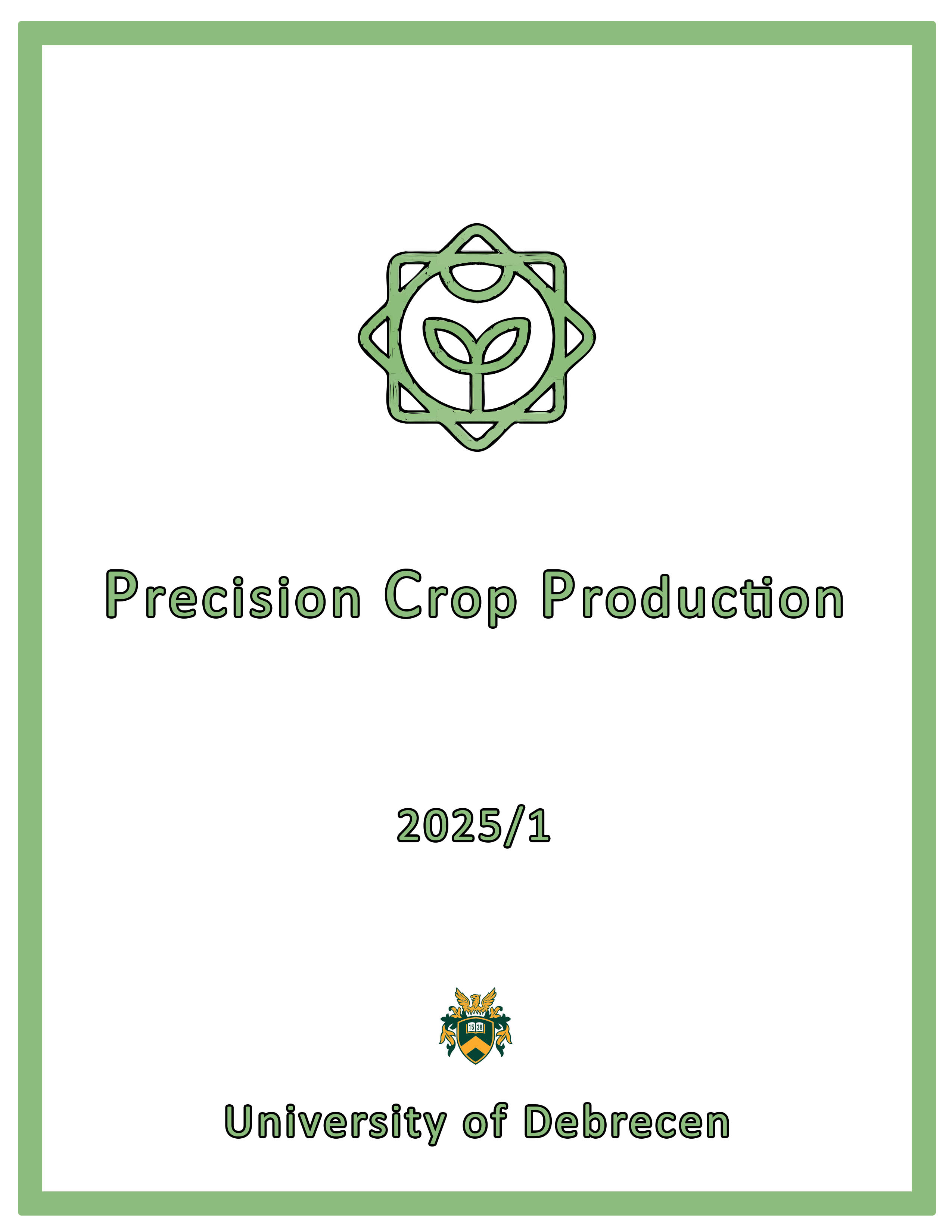Vol. 1 (2025): Precision Crop Production Current Issue
##issue.tableOfContents##
Articles
-
The role of sensor technology in sustainable and efficient agricultural production - Review
Views:25Agricultural sensor technology has become a cornerstone of modern precision farming over the past two decades. Our research focused on the applications of remote and proximal sensing technologies, with an emphasis on satellite, drone-based, soil-embedded, and plant-mounted sensors. The study analyzed the presence of sensors in scientific publications and the evolution of research trends. The results showed that the number of scientific publications on sensor technology has grown exponentially, particularly in the last decade, reflecting increasing scientific and practical interest in the field. It was found that modern advancements, such as nanotechnology, have significantly contributed to reducing sensor size and enhancing their sensitivity, thereby supporting sustainable agricultural practices. Sensor applications enable the optimization of water, nutrient, and energy use, contributing to agricultural sustainability. Our research highlighted the importance of sensor technology in improving production efficiency and addressing global agricultural challenges.
pdf17 -
The effect of soil tillage and nutrient supply on maize yield based on multi-year experimental results
Views:9To optimize maize (Zea mays) yield, soil tillage and nutrient supply play a key role. The application of appropriate soil tillage techniques and the precise application of nutrients can contribute to increasing yield, maintaining plant health, and developing sustainable agricultural practices. The aim of the study was to analyse the long-term yield performance of maize hybrids under different nutrient supply levels and basic tillage methods. According to the repeated measurement model, soil tillage, fertilization, and crop year had a significant (p<0.001) effect on maize yield. The integrated approach allows for the optimization of yield and the development of sustainable agricultural practices. Reduced soil tillage methods reduce soil erosion and improve soil biological activity.
pdf5 -
Precision maize stand analysis using remote sensing methods: plant density measurement with spectral data integration
Views:9The aim of this study was to use remote sensing with a drone equipped with a multispectral camera to take a stand survey of maize after the phenological stage of emergence, and to count the number of emerged plants and determine its accuracy. Our investigations were carried out at the University of Debrecen, Látókép Production Experimental Station in a sowing date long-term experiment. In the 2024 growing season, Sowing Date I was on 4 April and Sowing Date II on 12 April. The same maize hybrids with 8-8 different genotypes were used for each sowing date. There is a strong correlation between number of plants/plot and number of plants/rowx2 for the two plant density measurements presented in this paper, with an r value of 0.977*** (p < 0.001). Among the plant density and NDVI values, the correlation between number of plants/rowx2 at the second measurement time (July 4) was significant at r=-0.418***. The analysis of the relationship between number of rows and yield showed that the hybrids included in the study compensated well for differences in number of rows due to sowing or emergence and this did not translate into an increase or decrease in yield. By using the plant density count method and results to identify emergence imbalances, farmers can correct their crop stand management strategies in a timely manner. Knowing the exact number of plants can also be important for subsequent agrotechnical decisions.
pdf17 -
Predicting maize yield with a multilayer perceptron (MLP) model using multivariate field data
Views:14This study presents the findings of a multi-year maize field trial conducted on experimental plots between 2017 and 2019, focusing on the application of machine learning techniques to enhance yield prediction accuracy. A multilayer perceptron (MLP) neural network was employed to model the effects of agronomic treatments, environmental variation, and compositional traits. Six distinct modeling scenarios were developed to explore different combinations of input variables, with the grain yield of maize serving as the sole output parameter. These scenarios range from treatment-only models to those incorporating detailed quality and compositional data. The primary objective was to evaluate how well MLP models can capture the complex, nonlinear relationships influencing yield under varying conditions. The findings provide valuable insight into the role of machine learning in supporting decision-making for sustainable crop production, especially under diverse technological and environmental settings. The approach demonstrated here offers a foundation for more adaptable, data-driven strategies in agronomic optimization.
pdf22 -
Effects of solar radiation and night temperature on potential maize yield in two different crop years
Views:34Hungary's climate is undergoing change, and the heat unit (GDD) values have increased annually in the past nearly 50 years. In this study, we evaluate the performance of a maize hybrid in normal (2021) and drought (2022) crop years, along with the optimal agrotechnical factors (drip irrigation and high nutrient). In the potential experiment, we obtained a yield of 20.65t/ha in 2021 and 13.8t/ha in 2022. We examined the reasons for the large (33%) yield difference between the two years. By breaking down the weather data daily, it can be determined that the solar radiation (SR) and sunshine duration during the V6-V8 stage have an effect, and cloud cover affects the development of the reproductive organs of maize (ear differentiation). In the two years studied, we measured a significant difference in the SR value in the V6-V12 development stages (36% and 30% less SR was measured in 2022 vs 2021). The higher temperature (R1-R6) (2022) accelerated the phenological development of maize, so maize reached the black layer formation faster. The results indicate that in the future, we must also address the responses of maize to temperature changes with different levels of solar radiation and their dry matter incorporation dynamics.
pdf10

